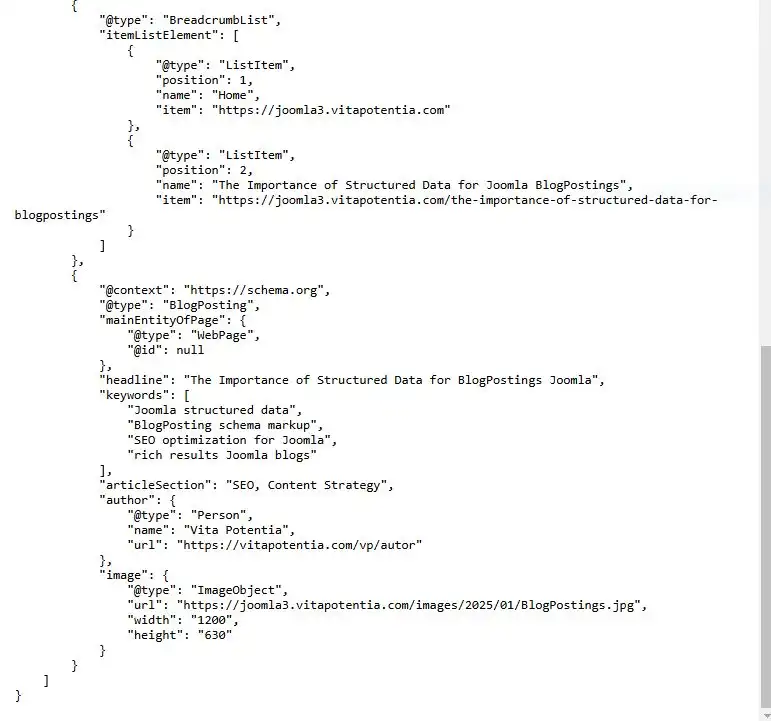- Super User
- Uncategorised
- Dilihat: 93
📘 Pertanyaan Umum (FAQ) untuk Plugin PSA Schema Joomla 3
Apa itu PSA Schema?
PSA Schema adalah plugin Joomla 3 yang dirancang untuk membantu pemilik situs web menambahkan data terstruktur (schema markup) dengan mudah ke situs mereka. Markup ini meningkatkan cara mesin pencari memahami konten situs Anda, meningkatkan kinerja SEO, dan meningkatkan kemungkinan cuplikan kaya muncul di hasil pencarian.
Bagaimana cara kerja PSA Schema?
Plugin ini memungkinkan Anda menyisipkan schema markup ke situs dengan memilih jenis schema yang telah ditentukan (misalnya: Artikel, Produk, Organisasi). Anda dapat mengonfigurasikan schema ini melalui pengaturan plugin, tanpa perlu pengetahuan pemrograman yang mendalam.
Jenis schema markup apa saja yang didukung oleh PSA Schema?
PSA Schema mendukung semua jenis data terstruktur. Untuk memaksimalkan potensinya, disarankan membaca dokumentasinya secara menyeluruh. Berikut adalah beberapa contoh jenis schema yang didukung:
- Organisasi: Untuk mendefinisikan detail tentang bisnis atau organisasi Anda.
- Artikel: Untuk postingan blog atau artikel berita.
- Produk: Untuk situs e-commerce agar memberikan informasi produk yang detail.
- Breadcrumbs: Untuk meningkatkan visibilitas navigasi di hasil pencarian.
- Acara: Untuk menampilkan acara dengan tanggal, lokasi, dan detailnya.
- FAQ: Untuk menandai pertanyaan umum seperti ini!
- Bisnis Lokal: Untuk bisnis dengan lokasi fisik.
Apakah PSA Schema kompatibel dengan semua template Joomla 3?
Ya, PSA Schema dirancang untuk bekerja dengan semua template Joomla 3. Namun, untuk template yang dikustomisasi, mungkin diperlukan penyesuaian kecil agar integrasi schema berjalan dengan baik.
Apakah saya memerlukan pengetahuan teknis untuk menggunakan PSA Schema?
Tidak, PSA Schema ramah pengguna dan tidak memerlukan keahlian teknis. Plugin ini menyediakan antarmuka sederhana untuk mengonfigurasi pengaturan schema. Bagi pengguna tingkat lanjut, ada opsi untuk menyisipkan kode schema JSON-LD kustom.
Bagaimana cara menginstal plugin PSA Schema?
Ikuti langkah-langkah berikut untuk menginstalnya:
- Unduh file plugin dari sumber resmi.
- Masuk ke panel administrator Joomla Anda.
- Navigasikan ke Ekstensi > Kelola > Instal.
- Unggah file plugin dan klik Instal.
- Setelah terinstal, aktifkan plugin di Ekstensi > Plugin.
Bagaimana cara mengonfigurasi jenis schema untuk situs saya?
- Buka Ekstensi > Plugin dan cari "PSA Schema".
- Klik nama plugin untuk membuka pengaturannya.
- Pilih jenis schema yang ingin Anda aktifkan (misalnya: Artikel, Produk).
- Isi kolom yang diperlukan seperti nama, deskripsi, URL, dan detail lainnya.
- Simpan perubahan.
Apakah saya bisa menggunakan beberapa jenis schema di halaman yang sama?
Ya, Anda dapat menggabungkan beberapa jenis schema (misalnya: Artikel dan Breadcrumb) di halaman yang sama. Namun, pastikan markup schema tersebut logis dan akurat untuk menghindari konflik.
Apakah PSA Schema mendukung situs multibahasa?
Ya, PSA Schema mendukung situs multibahasa. Anda dapat membuat konfigurasi schema berbeda untuk setiap bahasa menggunakan fitur multibahasa bawaan Joomla.
Apakah PSA Schema sesuai dengan pedoman Google?
PSA Schema menghasilkan schema markup sesuai dengan pedoman data terstruktur dari Google. Penting untuk memberikan informasi yang akurat dan jujur untuk menghindari penalti.
Bagaimana cara menguji apakah schema markup saya berfungsi dengan benar?
Anda dapat menggunakan Google Rich Results Test atau Schema Markup Validator:
- Salin URL halaman dengan markup PSA Schema.
- Tempelkan ke alat uji dan klik "Jalankan Tes".
- Periksa apakah ada kesalahan atau peringatan, lalu sesuaikan jika diperlukan.
Bisakah saya menyesuaikan kode schema yang dihasilkan?
Ya, pengguna tingkat lanjut dapat menambahkan kode JSON-LD schema kustom melalui pengaturan plugin. Ini memungkinkan fleksibilitas lebih besar jika opsi bawaan tidak mencukupi kebutuhan khusus Anda.
Apakah tersedia dukungan untuk PSA Schema?
Bagi pengguna yang membeli PSA Schema, tersedia grup dukungan dengan bot multibahasa untuk membantu siapa pun dalam bahasa apa pun.
Apakah PSA Schema akan berfungsi di Joomla 4?
PSA Schema juga memiliki versi untuk Joomla 4 dan 5.
Apa yang harus saya lakukan jika plugin menyebabkan konflik di situs saya?
- Nonaktifkan plugin sementara di Ekstensi > Plugin.
- Periksa apakah ada konflik dengan ekstensi atau template lain.
- Perbarui PSA Schema dan ekstensi lainnya ke versi terbaru.
- Hubungi dukungan jika masalah berlanjut.
Halaman ini adalah contoh FAQ. Lihat data terstruktur dengan memeriksa halaman, atau jika Anda lebih suka, instal SEO Bisbi di browser Anda untuk mempermudah.

 Bahasa Indonesia
Bahasa Indonesia  Arabic (اللغة العربية)
Arabic (اللغة العربية)  Русский (Россия)
Русский (Россия) 





